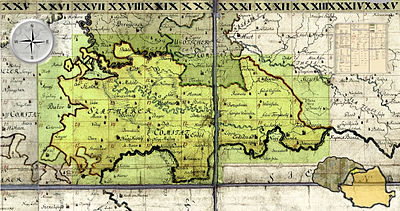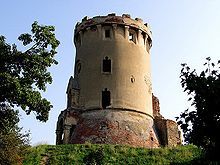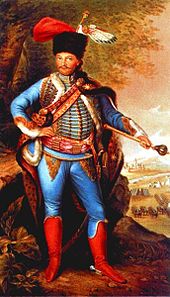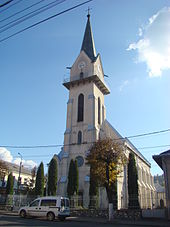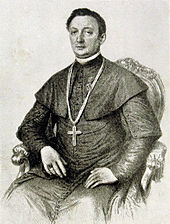Sathmar Swabians
The Sathmarer Swabians are a German-speaking minority in Romania and mainly settled in the Satu Mare district. The population of German origin from the Romanian districts of Bihor (especially in and around Oradea / Großwardein ), Sălaj and Maramureș is also assigned to this ethnic group. There are three Sathmarschwabian villages in Hungary. The Sathmar Swabians, along with other German-speaking minorities in Southeast Europe, belong to the Danube Swabian group .
Sathmarland
Today the Sathmarland is located in the northwest of Romania. Until the end of the First World War, Sathmarland belonged to Austria-Hungary , fell to the Kingdom of Romania through the Treaty of Trianon in 1920 , returned to Hungary in 1940 through the Vienna arbitration and was rejoined to Romania after the Second World War . It got its name from the Sathmar district town located on the Samisch (Someş), a tributary of the Tisza . The settlement area of the Sathmar Swabians not only includes the Swabian villages in today's administrative district of Sathmar, but also places with a German population, in the districts of Bihor , Salasch and Maramuresch .
history
The Sathmar Swabians are descendants of the farmers who emigrated mainly from Upper Swabia in the 18th century . In the years 1712 to 1815 Count Alexander Károlyi and his descendants recruited colonists from the Kingdom of Württemberg . Many emigrants came from today's districts of Ravensburg and Biberach .
prehistory
The first German settlers came to Sathmarland at the end of the 11th century. In 1230 King Andreas II issued Sathmar's German "guests" "dilectis et fidelibus nostris hospitibus Teutonicis de Zathmar Nemethi" a license similar to the golden license of the Transylvanian Saxons . At that time a number of German settlements emerged along the Samisch from Zillenmarkt (Zalău) to Burglos (Dej), whose residents enjoyed similar rights and freedoms as the Transylvanian Saxons. German settlers have also been confirmed in the mining towns of Frauenbach (Baia Mare) and Mittelstadt (Baia Sprie). As can be seen from the process documents of the Großwardeiner diocese from 1215, there were also German settlements around Großwardein (Oradea). The ancestors of Albrecht Dürer were also at home around Großwardein . From the family chronicle of the well-known engraver and painter it can be inferred that his father was born of a “family” “nit ferr from a small town called Jula (Gyula), eight miles away from Wardein, with a small village to the extreme Darbej name Eytas. .. “In the course of time, however, the German inhabitants of these medieval settlements were absorbed by the non-speaking population. The people of German origin living in Sathmarland today, in the districts of Maramuresch, Bihor and Salasch, are therefore not the descendants of these medieval settlers. Their ancestors weren't called to these areas until the 18th century. The medieval German settlement of Sathmar became extinct as a result of assimilation or raids by Tatars and later Turkish wars. Sathmar Castle was rebuilt in 1565 by Lazarus von Schwendi as captain general of the imperial troops in Hungary. The founder of the modern German settlement Sathmar is Count Alexander Károlyi.
Historical background
After the victory of Prince Eugene of Savoy in the Battle of Zenta in 1697, which paved the way for the Peace of Karlowitz (1699), the borders between the Habsburg and Ottoman empires were established by the rivers Tisza and Danube as well as Danube and Bosut and Save .
The uprising of Franz II Rákóczi , which broke out in Hungary in 1703 and in the course of which the Kuruzzen advanced to western Hungary and southern Styria , even as far as Vienna , came to an end in 1711 with the peace of Sathmar . Rakoczi's deputy, Count Alexander Károlyi, whose property in the Hungarian county of Sathmar had been devastated , signed it for the rebels . Count Alexander Károlyi and his successors recruited Catholics from Upper Swabia to repopulate their estates, mainly from the districts of Biberach and Ravensburg. Even after the end of the Spanish War of Succession in 1714, the economic situation in Upper Swabia only improved slowly. Even if Upper Swabia was spared immediate acts of war between 1707 and 1796: crop failures, cattle epidemics and the wars of the 18th century - the War of the Polish Succession (1733–1735), the two Silesian Wars (1740–1748) and the Seven Years War (1756–1763 ) - burdened the population again and again. The inheritance right in Upper Swabia , through which farms, fiefdoms and Selden were passed on in full to a single heir, ensured the preservation of the agricultural structure with a large number of medium-sized and large farms, but also impoverished those who were excluded or only one received little inheritance. Poor harvests and livestock epidemics, which made food expensive, did the rest.
Settlement
After the Hungarian Kuruzzen uprising (1703-11) ended by the Peace of Sathmar in 1711, a planned settlement of German colonists from Upper Swabia began in 1712, but not controlled by the state, but by the local magnate dynasty of the Károlyis . Count Alexander Károlyi and his descendants called in the years 1712-1815 colonists from the then Kingdom of Württemberg , mainly from Upper Swabia, to the Sathmarer Land, in order to repopulate the area depopulated by war, natural disasters and epidemics.
A few years before the first Banat Swabian procession , Alexander Károlyi began his settlement campaign in the Sathmarer Land. In 1712 he called the first settlers from Württemberg . 330 families, around 1400 people, answered his call. Due to the poor housing conditions and the lack of the promised aid, nearly a thousand people left the Sathmarer Land shortly after their arrival. Of the 1400 colonists only 450 remained; Of these, about 250 survived. As early as 1720, some of the settlers agreed to recruit new emigrants for Karolyi in Württemberg. From this year on, the settlement in Sathmarland by Counts Alexander, Franz , Anton and Josef Károlyi was successful. Larger groups of settlers came in 1726 with 181 families, 1737 with 106, 1760 with 58 and 1774 with 83 families. Between 1744 and 1751 Baron Wesselenyi founded the Alemannic settlement Kriegsdorf (Hodod), to which he called families of Protestant denomination from Baden-Durlach and Switzerland . In Batartsch (Bătarci) mainly carpenters and forest workers from Budweis in Bohemia were settled. After glassworks (Poiana Codrului) 1,801 glassblowers came from Austria. In Palota and in Kreisch-Tarjan near Großwardein, Swabians and Palatinate people were settled. After 1810, when the last Swabian community Terem was founded, colonization slowly ebbed. A new colonization with settlers from Upper Austria and Bohemia did not take place again until 1910 in Großtarna and Batartsch. Between 1770 and 1780, the Ärar recruited miners and craftsmen from the Salzkammergut , Upper Austria and the Zips for the salt mines in the Teresva Valley . Between 1778 and 1790 some of these settlers, who came from Bad Ischl , Gmunden , Ebensee and Zips, moved to Oberwischau (Vișeu de Sus) and Pfefferfeld (Băile Borșa), where they worked as woodworkers in the state forests and as carpenters. Their descendants, known today as Zipser , live mainly in Oberwischau, but also in Altwerk (Ocna Șugatag), Teutschau ( Tjatschiw ), Sighet (Sighetu Marmației) and the surrounding area. Between 1773 and 1812, foresters, miners and experts in the mining industry came to Frauenbach, Mittelstadt, Kapnik (Cavnic) and other mining locations in the Maramures region , mainly from Austria and Bavaria . With these settlements partly new villages were founded, partly Romanian and Hungarian villages were expanded.
The settlers were given a contract to use arable land, meadows and forests free of charge, as well as cattle, grain and timber, and in the first few years they were exempt from taxes and labor. They were granted a self-chosen community leadership. At the end of their free time they were obliged to pay five Rhenish guilders property tax, pay the ninth or tenth, do 15-16 days of forced labor and deliver the usual "gifts" (poultry, eggs, butter) on major holidays. If the settlers had fulfilled these obligations, they could leave the estate. The Sathmar Swabians were consequently not serfs subject to clods, but instead inherited subjects or "contracted front farmers ".
Revolution of 1848
The revolution of 1848 and the imperial waiver patents of the 1850s, which were ultimately enforced by the revolution, freed the Sathmar contract front peasants from their feudal obligations and brought about a great economic boom and the conversion to a modern farm.
After the Second World War
In September / October 1944 more than 3000 Sathmar Swabians fled under the protection of the German Wehrmacht and settled mainly in southern Germany, Austria and the United States. However, the majority stayed behind in their ancestral home. Of those who stayed behind, around 5000 men between 17 and 45 years of age and women between 18 and 35 years of age were lifted by gendarmerie and military units and deported to the Soviet Union for reconstruction work . Due to the decree No. 187/1945 of the Romanian government, real estate and real estate of all Germans were expropriated. German-speaking schools were banned until 1948. As a result of the general nationalization of 1948, the handicrafts and industrial companies were nationalized. The collectivization of agriculture took place in the mid-1950s. The state-controlled settlement of non-Germans in and around Sathmarschwabian localities contributed significantly to the decimation of the Sathmar Germans and to the shaking of their historically grown community.
School system
The Sathmarschwabian bourgeoisie merged relatively quickly with the Magyarism. This is also noticeable with regard to the cultural achievements of the Sathmar Swabians. School instruction played an important role in these Sathmarschwabian areas from the beginning. Already in the first years of settlement, the Sathmar Swabians established German schools. The statistics show that as early as 1731 in Fienen , 1741 in Schinal and Großmaitingen , 1779 in Bildegg , Sagas (1747) and Schandern (1767), Mérk (1772, in Hungary) and Terebescht (1777) school lessons were given in German . Also in 1779, Anton Karolyi had a "national school" built in Großkarol . This favorable development of the German school system in the Sathmarer Land was interrupted by the beginning of the 19th century Magyarization . In 1825 the Hungarian language was introduced into public life. The Catholic Church also served the general policy of Magyarization. In spite of this, the displacement of the language of instruction in the Sathmarschwabian communities proceeded only slowly. The Sathmar Swabian dialect was spoken both within and outside of the family. In the mixed towns and villages, however, German-language teaching had to give way more and more to Hungarian. Bishop Michael Haas vigorously opposed these general tendencies towards Magyarization . The reorganization of the German teacher training institute, the advanced training of active teachers, the admission of the Catholic grammar school in Sathmar (1863) to the series of public institutions and the continued existence of the German elementary schools are largely due to him. After the Austro-Hungarian compromise (1867) and the establishment of the dual monarchy , the Hungarian language was forcibly introduced in all non-Hungarian primary schools. The consequence of these measures was the consistent and progressive displacement of the German language of instruction and the complete Magyarization of German schools.
The annexation of Transylvania to Romania through the Treaty of Trianon had positive effects on the situation of the Sathmar Swabians. The Romanian state supported the national self-discovery of the Sathmar Swabians as a counterweight to the Hungarian separatism in Transylvania. In 1920 the introduction of the German language of instruction began. In 1928 there were already German schools in 15 municipalities. On January 10, 1926, the "German-Swabian People's Community Sathmar" was founded with the support of the Transylvanian Saxons and Banat Swabians. In 1933 there were school lessons in German in twenty-five communities. In the school year 1939/40 57 German teachers worked at 32 schools and taught 2925 students in their mother tongue. Young people from Sathmarschwäbisch attended German universities in Timişoara and Sibiu . But this cultural development was suddenly interrupted when Northern Transylvania , the Maramures, the Sathmar and Kreisch areas were again annexed to Hungary by the Vienna arbitration of August 30, 1940. Immediately measures were taken to continue the Magyarization of the German population in this area. As early as the 1942/43 school year, the number of Sathmarschwabian towns with German schools fell to fifteen, and German schools were closed in several towns.
After the Second World War, a new development began in the school system following the teaching reform of August 3, 1948. Gradually, German-speaking kindergartens and schools were reopened. From mid-1960, when the Romanian minority policy allowed some leeway, a lively German school and cultural work developed in Sathmarland. This is mainly due to the work of those teachers who studied in Timişoara from 1958 and in Sibiu from 1969 , but above all to the many Transylvanian Saxons and Banat Swabians who taught in Sathmarland, Oberwischau and Neustadt from the end of the 1950s that brought the cultural life of the Sathmar Swabians to life. The restrictions on schools and the press that came into force in 1971 and 1974 opened the door to an intensified process of assimilation that deprived the survival of the identity and culture of Germans in Romania from any future prospects. Due to the agreement between Romania and the Federal Republic of Germany in 1978, an increasing emigration of the Sathmar Swabians to Germany began around 1980.
Today there are 153 German-speaking kindergartens with 7,000 children and 133 schools with German-speaking departments and German-speaking schools with a total of 13,000 students. These are elementary schools and some high schools with complete German class trains up to grade 12. The newly opened German Lyceum "Johann Ettinger" in Sathmar was equipped with modern IT technology in 1997 during a visit by the Prime Minister of Baden-Württemberg , Erwin Teufel . In 1997 a German grammar school was set up again in Großkarol. Since the 1998–1999 academic year, Sathmar has even set up a German-speaking department for administrative sciences with 20 students from the Babeş-Bolyai University in Cluj.
population
Population development
Between 1712 and 1838 a total of 2072 families with over 8000 settlers from Upper Swabia settled in the 31 Swabian communities of the County of Sathmar. Around 1820 there were around 20,000 Swabian people living in Sathmar, and over 40,000 around 1930. In 1939 there were 40 settlements in Romania with around 30,000 Sathmar Swabians.
In the 1970s and 1980s, around 35,000 to 38,000 Sathmar Swabians lived around Sathmar. In addition, there are 4,000 of the municipalities that remained in Hungary in 1919 and around 8,000 people of German origin in the Maramuresch, Bihor and Salasch districts. Thus, around 50,000 people of German origin lived in the Sathmar Swabian settlement area. At the 1977 census there were 11429 Sathmar Swabians living in Romania. While only a few Swabians still live in the Swabian villages southeast of the Sathmarland, due to the emigration since 1978, there are still closed villages around Großkarol with Swabian population despite the emigration.
In the Romanian census of 2002, the following large municipalities and cities had a significant proportion of the population of German descent:
- In Satu Mare County :
- Foieni (Fienen) (41.6%)
- Petrești (includes the German settlements Petrifeld and Beschened ) (31.5%)
- Urziceni (includes the German settlements of Schinal and Schöntal ) (22.5%)
- Beltiug (includes the German settlements of Bildegg, Sagas, Socond / Sukunden and Schandra / Schandern / Alexanderhausen ) (15%)
- Tiream (includes the German-populated village of Terem ) (14%)
- Căpleni (Kaplau) (9.6%)
- Ardud (includes, inter alia, the German settlements of Erdeed and Madras ) (6.4%),
- Carei (Groß Karol) (2.3%; the cultural center of the Sathmarschwaben) and
- Satu Mare (Sathmar) (1.4%).
- In Bihor County :
- Sântandrei ( Sankt Andreas, includes the German village of Neupalota ) (7.4%)
employment
The main occupation of the Sathmar Swabians was arable farming , cattle breeding and, mainly in the southeast of Sathmarland, viticulture , where the vintners on the hills of the beech mountains achieved rich yields and built real wine cellar villages. The three-field economy and, towards the end of the 19th century, the land consolidation favored more rational work, the use of agricultural machines and overproduction. The Sathmarschwabian settlers included not only farmers, but also many craftsmen , such as millers, cutlers, nail and coppersmiths, carpenters, bricklayers, goldsmiths and silversmiths, Haffner and others. At the beginning of the 19th century, for example, the Sathmar bootmakers organized themselves into a guild and had statutes drawn up in German.
Political representation
In contrast to the Banat Swabians or the Transylvanian Saxons , emigration to Germany was less pronounced among the Sathmar Swabians, so that a significant proportion of the population in numerous localities is of German descent. This means that the Sathmar Swabians are the only German ethnic group in Romania with prospects for their continued existence. The political representation of the Sathmar Swabians and the other German ethnic groups of today's Romania is the Democratic Forum of Germans in Romania (DFDR).
The "German Forum of the Sathmar Swabians", a subdivision of the DFDR, provides seven mayors in the Sathmar district as a political party, maintains a foundation for economic development and organizes youth and cultural work. In accomplishing its tasks, it is supported both financially and in terms of content by the “Landsmannschaft der Sathmarer Swabians in Germany” and the “Aid Organization of Sathmarer Swabians”. Considerable help for self-help by the Federal Government of Germany in the social, cultural and economic area should make it easier to stay in Sathmarland.
In 1962, the district of Biberach took over the sponsorship of the Sathmar Swabian Landsmannschaft.
dialect
The Sathmar area Großkarol and Sathmar is the only Danube Swabian settlement area (almost) uniformly Upper Swabian , only in Kriegsdorf there is an Alemannic dialect, similar to the Banat local dialect of Saderlach . In Neupalota , Palatine - Moselle-Franconian , similar to many Banat dialects, is spoken and in Oberwischau, Großtarna and Batartsch there is a Bavarian-Austrian language island that is related to the Zipsern from Oberwischau.
The Sathmarer Swabians form the core of the "Sprachschwaben" among the Danube Swabians, because they did not adopt Rhine-Franconian dialects like many Swabians of origin , and therefore they are most justifiably called "Swabians".
The linguists Hugo Moser , Hermann Fischer and Stefan Wonhas dealt with the research of the Sathmarschwäbischen dialect . According to these researchers, the dialect of the Sathmar Swabians belongs to Swabian - Alemannic , because the Middle High German diphthongs "ie" and "uo" have remained, Middle High German "st" as "scht" ( Nuschterle, Wurscht, Schtuoark ) "sp" as "schp" ( schpeet, schpotta ) occurs. In addition, “-en” becomes the weak-tone “e = a” ( come - kumma, gone - ganga ). That it is a northern Alemannic dialect shows the retention of the "k" in the wording. The diphthongization of the Middle High German "i" and "u" proves that the Sathmarschwabian dialect belongs to the Swabian branch of Northern Alemannic, namely to the southern Upper Swabian , since the Middle High German "e" and "o" as well as "i", "u" come before one Nasal sounds remain unchanged.
Songs
The song collection "Old Swabian Folk Songs from Sathmar" by Hugo Moser is the first collection of Sathmar Swabian folk songs. In the years from 1928 to 1938, with the help of the teacher and song collector Stefan Koch, he began to research and compile the Sathmarschwabian folk song. Moser had tried himself to revive Swabian songs in Sathmar. But the turmoil of World War II initially left a large gap in the area of singing. At the beginning of the 1960s, however, people returned to the traditional customs after teachers in German schools had been allowed to sing German and Swabian songs since 1948. After Hugo Moser's song collections, the song recordings by Helmut Berner and Claus Stephani from 1965 to 1984 supplemented Moser's first research and collection results and expanded them with legends, "Gschichtle" and other folkloric evidence. Wolfgang A. Mayer from the Johannes Künzg Institute for Folklore in Munich was able to record around 100 songs on tape in 1974 and 1975. Pastor and folklorist Anton-Joseph Ilk , who worked as a pastor in Sathmar from 1977 to 1984, discovered a handwritten collection of 32 songs on the floor of the Herz Jesu Church, which can largely be traced back to Hugo Moser. The Collegium Suebicum Sathmarense was formed in 1977 in Großkarol. It consists of musicians who have focused their research on the interpretation of Sathmarschwabian songs since 1990.
In the secular songs of the Sathmarer Swabians, those crystallize out that show the connection with the original Swabian homeland in a striking way. The majority of the non-Swabian songs are melodies from Switzerland, Vorarlberg, Saxony, Bavaria, Slovakia and Austria. With the self-assertion against other influences from the surrounding cultures of Hungarians and Romanians also native songs emerged. The song "Am Samisch und am Krasnastrand", composed by Carl Müller and set to music by Josef Baber in 1936, is considered the actual home song of the Sathmarschwaben. “Hui sott i gauh”, the song about the potato grating, can not only be found in Sathmarschwaben, but also in other German landscapes with different dialects and melodies.
A specialty are the sung ballads in the Sathmar area. “The sold miller”, known from all over German-speaking countries, is one of them. There are also around 50 published sacred songs from the Sathmar area.
Personalities
- Johann Scheffler (1887–1952), bishop
- Wolfram Benz , writer
- Josef Baber , composer (1910–?)
- Stefan Schmied , historian (1919–1978)
- Maria Balogh , writer
literature
- Stefan Schmied: History of the Sathmar German school system. From the beginning until 1971. Self-published: Leubas / Kempten, 1972
- Claus Stephani : Valley of the silent violins. Folk tales from the Oasch and Sathmar lands. Ion Creangă Published by Bucharest, 1979
- Ferdinand Flesch: Contributions to the history of the Sathmarer Swabians. 50 newsletters. Self-published: Ravensburg, 1984
- Helmut Berner; Claus Stephani: Volksgut of the Sathmarschwaben. (Series of publications by the Commission for East German Folklore in the DGV eV: Vol. 32). NG Elwert Verlag: Marburg, 1985
- Ernst Hauler: Sathmar and his Swabians. Eckart-Schriften, 112, Vienna 1987
- Claus Stephani: Fairy tales of the Romanian Germans. (Series: The fairy tales of world literature). Eugen Diederichs Published by München, 1991
- Ernst Hauler: Only they still spoke German. On the death of Viktor habenicht . In: Der Donauschwabe, Aalen, 41/39, September 29, 1991, p. 4
- Claus Stephani: Fairy tales of the Romanian Germans. (Series: The fairy tales of world literature). Eugen Diederichs Published by München, 1991
- Claus Stephani: The Sathmarschwaben in search of ethnic identity. In: History, present and culture of the Danube Swabians. Texts from the current discussion. Sindelfingen, issue 2.1992. Pp. 57-63
- Claus Stephani: Sathmarschwäbische life stories. (Series of publications by the Commission for East German Folklore in the German Society for Folklore: Vol. 66) NG Elwert Verlag: Marburg, 1993
- Claus Stephani: Legends of the Romanian Germans. Eugen Diederichs Published by München, 1994
- Nicolae Gelenczer: The Sathmarschwaben - An outline from a historical and sociological point of view. GRIN Verlag, 2007
Web links
- sathmarerschwaben.de , Association of the Sathmarer Swabians and Oberwischauer Zipser eV
- angele-sippe.org , Kurt Diemer: Emigration from Upper Swabia in the 18th century , excerpt from BC - Local history sheets for the district of Biberach 2010/1 , published by the Society for Home Care (Art and Antiquity Association) in the city and district of Biberach eV
- genealogienetz.de , list of villages in the area of Satu Mare
- genealogienetz.de , map of villages in the Satu Mare area
Individual evidence
- ↑ sathmarer-schwaben.de ( Memento from April 8, 2011 in the Internet Archive ), Die Sathmarer Schwaben
- ↑ genealogienetz.de , Sathmarland, map
- ↑ a b c d e f g h i j k l German settlers in the north-west of Romania ( Memento from February 2, 2014 in the Internet Archive ), accessed on January 25, 2014
- ↑ District Office Ravensburg : The Sathmar Swabians - The Choppy Fate of German Settlers in Northwest Romania ( Memento from February 2, 2014 in the Internet Archive ) from October 17, 2010, accessed on May 20, 2010
- ^ German settlement areas in south-eastern Europe after the Turkish era , accessed on January 26, 2014
- ↑ a b c d Kurt Diemer: Emigration from Upper Swabia in the 18th Century , accessed on January 26, 2014
- ^ The German Eastern Territories , Die Sathmarer Schwaben, accessed on January 25, 2014
- ↑ In the beginning was the new home , accessed on January 25, 2014
- ↑ a b Hans Gehl: The Sathmarschwäbischen dialects and their language carriers , accessed on January 26, 2014
- ^ The small Upper Swabia in Romania , accessed on January 27, 2014
- ↑ Helmut Berner: The dialect of the Sathmar Swabians along with some of their peculiarities ( Memento from September 24, 2015 in the Internet Archive ), accessed on January 29, 2014
- ↑ a b Wolfram Benz: Das Liedgut der Schwaben in Sathmar / Romania , 1996, p. 7, accessed on January 26, 2014
- ↑ Wolfram Benz: Haim sell i 'geih.
- ↑ Pope approves canonization for Italian priest, 35 beatifications , accessed on January 29, 2014
- ↑ a b c Schwabenpost No. 9. III. Volume - September 2009 , accessed on January 29, 2014
- ↑ E-Book , Nicole Gelencser: Die Sathmarschwaben - An outline from a historical and sociolinguistic point of view

